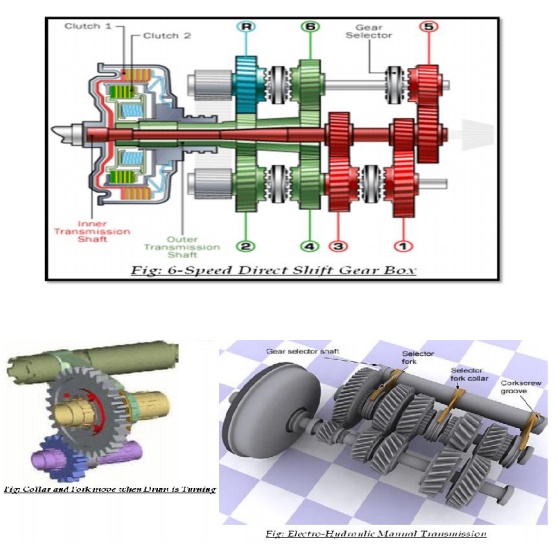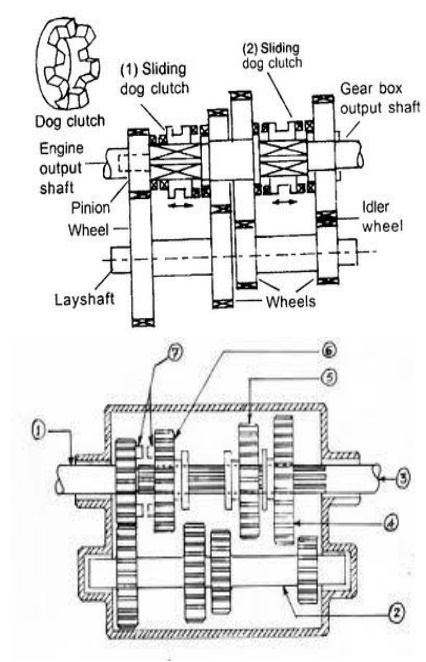Chapter: Mechanical : Automobile Engineering : Transmission Systems
Semi Automatic Transmission
Semi Automatic Transmission
A semi-automatic transmission (also known as clutch less
manual transmission, automated manual transmission, e-gear, shift-tronic,
flappy paddle gearbox, or paddle shift gearbox) is a system which uses
electronic sensors, processors and actuators to do gear shifts on the command
of the driver. This removes the need for a clutch pedal which the driver
otherwise needs to depress before making a gear change, since the clutch itself
is actuated by electronic equipment which can synchronize the timing and torque
required to make gear shifts quick and smooth.
The system was designed by European automobile manufacturers
to provide a better driving experience, especially in cities where congestion
frequently causes stop-and-go traffic patterns. Like a tiptronic transmission,
a semi-automatic transmission can also be switched to manual mode to perform
gear shifting at the drivers wish.
The
two most common semi-automatic transmissions
·
Direct shift transmission (or dual-clutch
transmission)
·
Electro-hydraulic manual transmission (or
sequential transmission)
Direct shift transmission: In direct shift transmission direct
shift gear box is used. The Direct-Shift Gearbox or D.S.G. is an electronically
controlled, twin-shaft dual-clutch manual gearbox, without a conventional
clutch pedal, with full automatic or semi-manual control.
Unlike the conventional manual transmission system, there are
two different gear/collar sets, with each connected to two different
input/output shafts. The outer clutch pack drives gears 1, 3, 5 and reverse. It
is just like two conventional manual transmission gear boxes in one. The inner
clutch pack drives gears 2, 4, and 6. Instead of a standard large dry
single-plate clutch, each clutch pack is a collection of four small wet
interleaved clutch plates.
Due
to space constraints, the two clutch assemblies are concentric. To
automatically shift
from 1st
gear to 2nd gear, first the computer detects that the spinning speed of the
input shaft is too high, and engages the 2nd gear’s collar
to the 2nd gear. The clutch then disengages from 1st gear’s input shaft, and
engages the 2nd gear’s input shaft. Controlled by computer, the gear shift
becomes
extremely fast compared with a
conventional manual transmission.
Using
direct contact of the clutch instead of fluid coupling also improves power
transmission
efficiency. Another advanced technology used
for direct shift trans-mission allows it to perform
“double clutching” by shifting the gear to neutral
first, adjusting the spinning speed of the input shaft, and then shifting
to the next gear. This makes gear shifting very smooth.
Operation Modes Of D.S.G.:- "D" mode:
When the motor vehicle is stationary, in neutral, both clutch
packs are fully disengaged. When the driver has selected D for drive (after
pressing the foot brake pedal), the transmission's first gear is selected on the
first shaft, and the clutch prepares to engage. At the same time, the second
gear is also selected, but the clutch pack for second gear remains fully
disengaged. When the driver releases the brake pedal, the clutch pack for the
first gear takes up the drive, and the vehicle moves forward. Pressing the
accelerator pedal increases forward speed. As the car accelerates, the
transmission's computer determines when the second gear (which is connected to
the second clutch) should be fully utilized.
Depending on the vehicle speed and amount of power being
requested by the driver (full throttle or part-throttle normal driving), the
D.S.G. then up-shifts. During this sequence, the DSG disengages the first
clutch while engaging the second clutch (all power from the engine is now going
through the second shaft), thus completing the shift sequence. This sequence
happens in 8 ms, and there is practically no power loss.
Once the vehicle has shifted up to second gear, the first gear
is immediately de-selected, and third gear (being on the same shaft as 1st and
5th) is pre-selected, and is pending. Once the time comes to shift, the second
clutch disengages and the first clutch re-engages. This method of operation
continues in the same manner up to 6th gear.Downshifting is similar to
up-shifting but in reverse order. The car's computer senses the car slowing
down or more power required, and thus lines up a lower gear on one of the
shafts not in use, and then completes the downshift.
The actual shift timings are determined by the D.S.G.'s
Electronic Control Unit, or E.C.U., which commands a hydro-mechanical unit, and
the two units combined are called a "mechatronics" unit. Because the
D.S.G. & E.C.U. uses "fuzzy logic", the operation of the DSG is
said to be "adaptive"; i.e. the DSG will "learn" how the
user drives the car, and will tailor the shift points accordingly.
In the vehicle instrument display, between the speedometer and
tachometer, the available shift positions are shown, the current position of
the shift lever is highlighted, and the current gear ratio is also displayed as
a number. Under "normal", progressive acceleration and deceleration,
the DSG shifts in a "sequential" mode, i.e. under acceleration: 1
> 2 > 3 > 4 > 5 > 6, and the same sequence reversed for
deceleration. However, if the car is being driven at sedate speeds, with a
light throttle opening, and the accelerator pedal is then pressed fully to the
floor, this activates the "kick-down" function. During kick-down, the
DSG can skip gears, going from 6th gear straight down to 3rd gear.
"S" mode:
The floor selector lever also has an S position. When S is
selected, "sport" mode is activated in the DSG. Sport mode still
functions as a fully automatic mode, identical in operation to "D"
mode, but up-shifts and down-shifts are made much higher up the engine
rev-range. This aids a sportier driving manner, by utilizing considerably more
of the available engine power, and also maximizing engine braking. However,
this mode does have a worsening effect on the vehicle fuel consumption, when
compared to D mode. S is also highlighted in the instrument display, and like D
mode, the currently used gear ratio is displayed as a number.
Manual (Tiptronic) Mode:
Additionally, the floor shift lever also has another plane of
operation, for manual or tiptronic mode, with spring-loaded "+" and
"−"
positions. This plane is selected by moving the stick away
from the
driver (in vehicles with the drivers seat on the right, the lever is pushed to
the left, and in left-hand drive cars, the stick is pushed to the right) when
in "D" mode only. When this plane is selected, the D.S.G. can now be
controlled like a manual gearbox, even though under a sequential shift pattern.
The readout in the instrument display changes to 6 -5- 4- 3-
2- 1, and just like the automatic modes, the currently used gear ratio is
highlighted. To change up a gear, the lever is pushed forwards (against a
spring pressure) towards the "+", and to change down, the lever is
pulled rearwards towards the "−".
The DSG box can now be operated with the gear changes being
(primarily) determined by the driver. This method of operation is commonly
called "tiptronic". When accelerating in Manual/tiptronic mode, the
D.S.G. will still automatically change up just before the red-line and when
decelerating, it will change down automatically at very low revs, just before
the engine idle speed (tick over). Furthermore, if the driver calls for a gear
when it is not appropriate (i.e., engine speed near the red-line, and a down
change is requested) the D.S.G. will delay the change until the engine revs are
at an appropriate level to cope with the requested gear.
Paddle Shifters:
On certain "sporty” or high-powered
cars paddle shifters are available. The paddle shifters
have
two distinct advantages: the driver can safely keep both hands on the steering
wheel when using the Manual/tiptronic mode; and the driver can immediately
manually override either of the automatic programs (D or S) on a temporary
basis, and gain instant manual control of the D.S.G. box.
If the manual override of one of the automatic programs (D or
S) is utilized intermittently, the gearbox will "default" back to the
previously selected automatic mode after a predetermined duration of inactivity
of the paddles, or when the car becomes stationary. Alternatively, should the
driver wish to revert immediately to automatic control, this can be done by
holding the "+" paddle for at least two seconds.
Electro Hydraulic Manual
Transmission:
In
electro-hydraulic manual transmission (also known as sequential transmission)
the gear set
is almost
the same as the conventional transmission system, except that the shifting of
the se-lector is not an “H” pattern. Instead, all selector forks
are connected to a drum. The drum has several
grooves,
and each has a ball sliding in it. Each fork hooks up to a ball and can be
moved forward and backward when the drum is turning. Based on the pattern of
the grooves on the drum, by turning the drum, each fork can move forward and
backward in turn, which makes gear selection sequential.
Therefore,
it is impossible for an electro-hydraulic manual transmission to perform a gear
shift from 1st to 3rd or 4th to 2nd. The shifting must be sequential, like 1st ▬►
2nd ▬► 3rd ▬►4th, or
4th▬►3rd▬►2nd▬►1st.


Related Topics